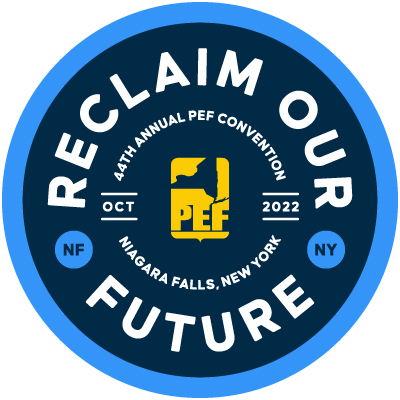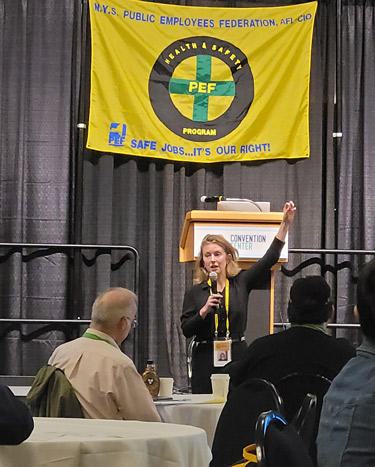
 Delegates hit the ground running on the second morning of Convention, coming together to discuss what makes a successful health and safety campaign during the annual Health and Safety Breakfast workshop.
Delegates hit the ground running on the second morning of Convention, coming together to discuss what makes a successful health and safety campaign during the annual Health and Safety Breakfast workshop.
“Health and safety is the nexus of the labor movement,” said Health and Safety Specialist Veronica Foley, leading the workshop. “We are here to work with you on strategy. Whenever you have a hazard, contact us.”
The morning touched on studying how employees participate in the decision-making process; how employees know about decisions that are made; and how agencies have made strides toward mitigating health and safety concerns that have been brought to their attention.
The delegates pointed to using worksite bulletin boards as a good way to keep members informed. Foley took it a step further, suggesting that a memo on any decisions signed by both labor and management representatives would go a long way to reinforcing faith and trust in the system.
A member brought up lack of action on any monetary issues on health and safety agendas. To combat this, Foley suggested backing up the ask with factual data, like worker’s compensation stats.
“Worker’s compensation costs can be astronomical for agencies,” she said. “It costs money when people go out. Look at what data can be mined to prove a case.”
Breaking out into groups, the attendees focused on choosing a health and safety concern and setting an objective to address the concern, as well as how to get members on site to participate in a campaign. They voted on one campaign to delve further into during the evening workshop.
Digging into the ‘winning’ campaign

After plenary session, delegates returned to the health and safety arena to further explore the concern voted on – workplace violence – and how to work toward mitigation.
One of the night’s case studies focused on residential rehabilitation units (RRUs) developed by the Department of Corrections and Community Supervision (DOCCS) following passage of the Humane Alternatives to Long Term Solitary Confinement (HALT) legislation.
An RRU is a separate housing unit used for therapy, treatment, and rehabilitative programming of incarcerated individuals who have been determined to require more than 15 days of disciplinary confinement, according to DOCCS.
Members at a DOCCS facility reported increased workplace violence incidents, with lack of monitoring systems and inadequate communications, among other issues.
Foley broke down the process of tackling the issue: setting a major health and safety objective, solutions, and activities.
“Identify a major health and safety objective,” she said. “A major health and safety objective is an overall statement of the desired outcome related to the safety, health, and well-being concern identified. Solutions are more specific, targeted objectives for what could be done to accomplish the major goal. Activities are specific actions that would bring the organization closer to achieving a solution.”
Attendees set their case-study objective as reducing workplace violence incidents by 40 percent annually in the RRU at Upstate Correctional Facility.
They then proceeded to the next step, brainstorming solutions and activities.
The first idea was to analyze data and identify workplace violence trends. Members highlighted report writing training, educating supervisors on reporting, and ensuring that all workplace violence incidents are reported as activities to support this solution.
“Create a professional write-up to bring to the table,” Foley said. “Data is crucial to prove there is a problem.”
This is where a worksite’s SH 900 logs can be leveraged, she said. An employer is required by state law to keep an SH 900 log of all work-related injuries and illnesses.
“You have a right to request them and there is no cause needed,” Foley said.
Increasing staffing levels became solution two, supported by activities such as reviewing current staffing ratios and defining the best-case ratio for the RRU.
Solution three was implementing additional safety measures, with identified activities including hooking up monitoring consoles already in-house; continuing to roll out GPS locator alarms; and strategic placement of incarcerated individuals based on their potential for violence.
“Health and safety staff is here to take these identified activities and consider strategies for moving forward and to bring these activities to fruition,” Foley said.
To contact PEF Health and Safety, email healthandsafety@pef.org or call 800-342-4306, ext. 254.

